Dropping an American V8 engine into a nimble British sports car is a tried-and-true recipe for go-fast performance and handling. Examples that immediately come to mind are the AC Cobra, Sunbeam Tiger, and TVR Tuscan, all of which were fitted with a Ford V8. A homebrew approach to his formula is this 1958 Triumph TR3 here on Craigslist which is powered by a Chevrolet 327 taken from a Corvette. It is a long-term project that is nearly ready to hit the road. Thanks to Barn Finds reader Jayden P. for the tip!
Very little is said about the condition of the body, so the photos will have to speak for themselves. Most of the original red paint seems to have been ground off and what remains is bare rusted metal. Based on the title of the ad, the seller seems to be trying to sell it as a “rat rod” look but it might look better top coated, even just in primer. Despite the intentionally rusted look, there does not seem to be any indication of any rotted metal. A larger transmission tunnel has been welded in to accommodate the drivetrain swap and the frame appears to be in decent shape. Western wheels with fat new BF Goodrich white letter tires fill out the wheel wells nicely and should provide the extra grip required for the added power.
The interior is nicely trimmed in nice real tan leather which creates a contrast with the crusty exterior. The speedometer and tachometer are original, and the gauges in the middle of the dash are aftermarket but in the stock locations. A three-spoke detachable race-style steering wheel is fitted. There’s a new windshield included, and a big rollbar has been fitted that will hopefully protect a driver if things get out of hand with a V8 under the hood.
Where the two-liter four-cylinder Triumph mill used to reside is a blueprinted 327 Chevy small block built to 1967 Corvette specs. The block was bored .040 over and is fitted with forged pistons and a new solid-lifter cam. This engine is topped by a pair of “double-hump” cylinder heads fitted with stainless steel valves. This build is said to be good for 365 horsepower which is delivered through a new flywheel and clutch to an unspecified five-speed transmission and a driveshaft with new U-joints. Cooling is provided by a new radiator and fan from a Chevrolet SSR. The suspension has been refreshed and the brakes have been gone through with new rotors and calipers up front and drums and wheel cylinders in the rear. Hopefully this be enough to stop a car that now makes nearly four times as much power as it did in stock form.
The price has been reduced from $8700 to $8200 and most of the work has been complete, so this could be a good deal, especially when compared to the price of other British sportscars with V8 power. Would you go the extra mile and finish this one off with new paint or drive it as-is in its distressed state?
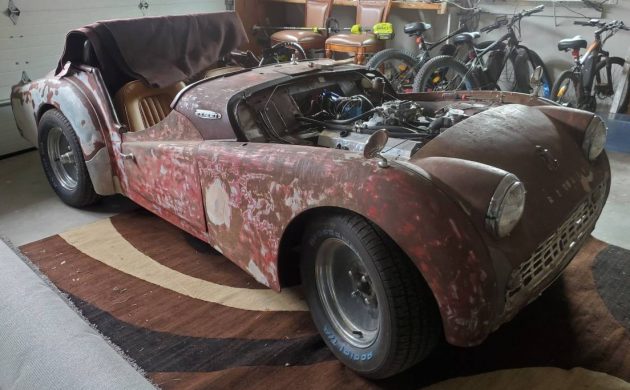
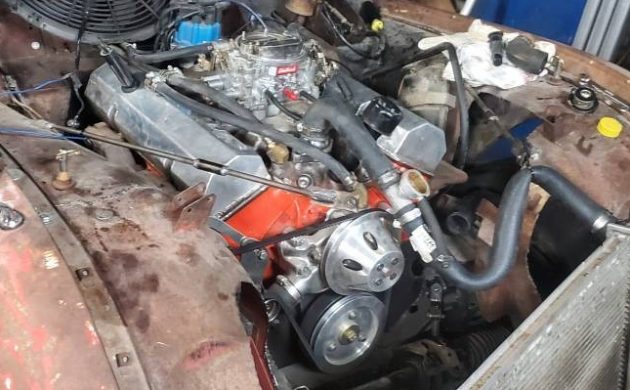
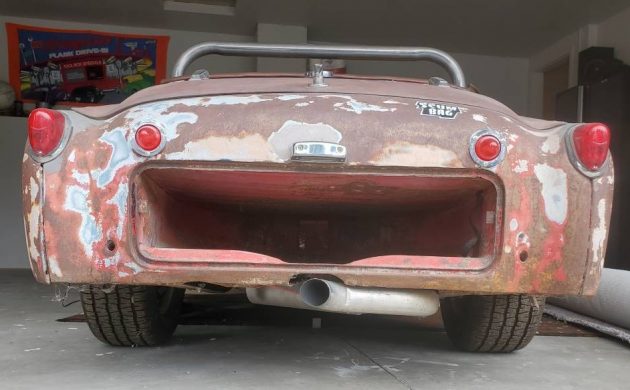
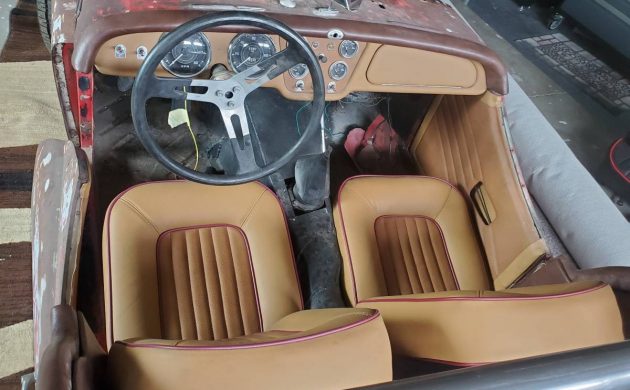
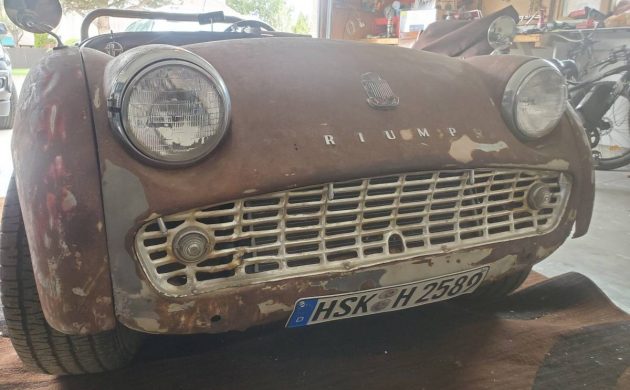


Found illustrating the Wiki entry for “Bad Ideas”.
Suddenly it all came together in Billy’s mind: “route the exhaust pipe up & over behind the seats for a combination roll bar / neck heater for cool weather, top down driving”!
mike b, whatever makes you say stuff like that should be packaged and sold. Don’t ever change.
The car is a mess. There is no theme, it has the feel of something pieced together using whatever parts they found for cheap at the swapmeet.
When you look at projects like this, it’s best to price it at 50% of the value of its parts on the secondary market, that way you protect your interests if the project is worse than expected and you need to change directions with it.
Steve R
just as a counterpoint…..the 327 is as light or lighter than the cast iron 4 banger in the TR3. Just sayin….
Always amazed how many wrecked Corvettes donated their small blocks compared to say four door wagons.
Could be a fun car when finished. But I’m not the one that could finish it.
I’d like to hear from our British cousins on this abomination. Here you have a vehicle designed for a 85 hp (?) and suddenly you have 4 times that, what’s the worst that can happen? I think what happens in these deals, is they sound oh so nice on paper, and a “maiden voyage”, if this even got that far, proves far different results. I’m sure a fun project for someone to build, but I think actually driving it was a scary ride.
i have a sunbeam MKII tiger lots of fun to drive 230 hp at rear wheels on dyno still the org 289
If anybody wants me I’ll be in my garage running $100. bills through my shredder.
It appears to me this that thing is cobbled together. Unless I’m mistaken, the upper radiator hose is far too long and seems to be held in position with a zip tie. If I’m not mistaken, how much effort would have been required to find an appropriately sized hose?
Another photo shows a shorter hose. The long hose just needs to be cut.
Author us forgetting Allard, Brough, Griffith, Jensen and Railton for a few more Anglo American efforts.
Yup, those too. I just listed out the first ones I thought of.
I am not opposed to this type of Frankenstein, but there are a few things that do not add up. Look at the craigslist ad. Why is there a photo taken in a different garage with three engines on stands, none of which found their way into this car? No mention of anything done to the rear axle to handle the additional power. Why put so much effort into the interior, when cooling hoses were not even cut to the correct length. Why list it as an automatic when it has a manual transmission. Was the electric fan ever installed or is it just laying there? If he wants to see the job get finished, he may need to lower his price. If he wants the money he invested, he needs to sell it one part at a time. Just my opinion, but I have done swaps and know what it takes.
I find this statement interesting. “Dropping an American V8 engine into a nimble British sports car is a tried-and-true recipe for go-fast performance and handling.” This might be true of an AC or TVR. However, a cast iron Chevy 327 is going to off balance a Triumph TR3 and stress it beyond belief. I’ve seen this done, successfully in Jaguars, Ferrari and even Rolls Royce, Which is why the Triumph/Rover/Jaguar’s clone of the GM 215 CID Aluminum V8 was used in several of Triumph and Rover cars. That’s basically the same engine that’s in Lander Rover SUVs.
I had a friend, that did this, with a Chevy 310 CID V8 in a Triumph GT6. After six months he pulled the Chevy engine and sold it to a hot rod guy. He then installed an Oldsmobile aluminum V8 and change the front springs, as the Olds engine was lighter than the “TR” six cylinder engine.
When I was young and the neurons in my frontal lobe hadn’t connected yet, I dropped a Buick 215 V8 in a ’59 Volvo PV544. That engine was about the same weight as the Volvo B18b engine, that I had in there previously. I then had 200 HP, without modifying the little V8 and compromising the reliability and handling. (handling in a Volvo 544 is a relative term.) Mileage, although still pretty good, wasn’t an issue back then, at 35.9 cents a gallon for 105 Octane premium.
I remember that the torsion control on a 544 Volvo rear end was a torque rod attached to the oil-can sheet metal supporting the rear seat. Even the stock rear end caused that oil-can to stretch! I can imagine what a V8 would do there. Just another engineering challenge! –Of which there are so many when doing a mill transplant. I put a V8 Chrysler hemi in a Jeep Wagoneer once. It was GREAT accomplishment shifting through all combinations of forward compound transmission. We got pretty good at it. Then, My brother returned the original 4 banger to it. Different strokes for different folks . HA!
Somebody’s fevered dream of a “sleeper” with a price tag.
Located in Twin Falls, ID
I’m a firm believer in V8 swaps having a real Tiger and a overly blessed V8 Healey. But I have other small cars with non V8 swapped engines too. I would put a nice light Japanese power plant with a 5 or 6 speed in this and never worry about over steering into the first tight turn at the end of the block.
Should have just bought a Corvette!
The Triumph frame is pretty stout. And I am fairly sure that the overall weight of the V8 and 5 speed will only add about 150-200 pounds over the LUMPS that came out. (British vehicles of this generation were incredibly heavy for the power and size. I swapped in a Cologne 2.8 and T5 5 speed in an MGB and had a total weight decrease of 60 pounds. Plus the weight was moved farther back and the front end of the car came up almost 1″.)
Yes, it is “unfinished”, AND there could be a rusted out frame. But a close inspection could disclose a cool project!
Take note that the engine IS rearward of the center line of the front wheels. SO, handling could/will need to be addressed more for the power than the weight. Now the brakes, and the rear differential, that is another story. If time and space were not a concern for me, I would be tempted if the “tin worm” had not had it’s way.
It’s running no more than 6 pounds per horsepower. In other words, it makes twice the power-to-weight of a Dodge Viper.
Sounds fun!
Chunk, all I could think about that “swap” is: On a road course it would handle like you were riding the business end of a whip, or under steer something awful. BRAKES? “We don’t need no stinking brakes,” or words to that effect.
James C. Simpson, not to worry. Prior to the V8 engine, I raced the Volvo as a street modified, with a B18b engine, a big SU carburetor on a Judson supercharger. I had to add some weight to the car, for the class. Any guess where some of the weight was added?
A lot of things were modified. It still used the Volvo trans and third member, without any failures. That was a surprise. also, front and rear anti-sway bars were added. I got my advise and some help from an old racing Mechanician.
It need better brakes. The old guy looked at the bake shoes and Said, “Those look like Studebaker. Studebaker has more friction material.” Sure enough, those worked. Wider wheels came from a ’55 Ford.
You can see a painting, that I did, of my Volvo on my Facebook: DJ Autoart.